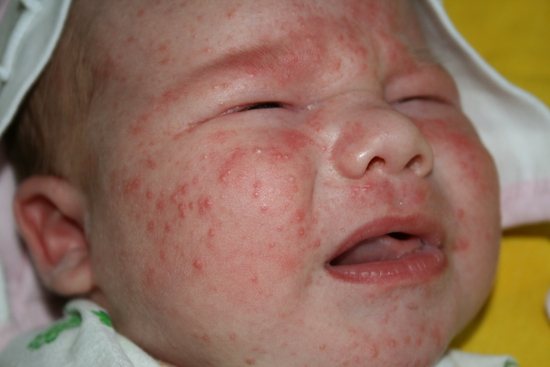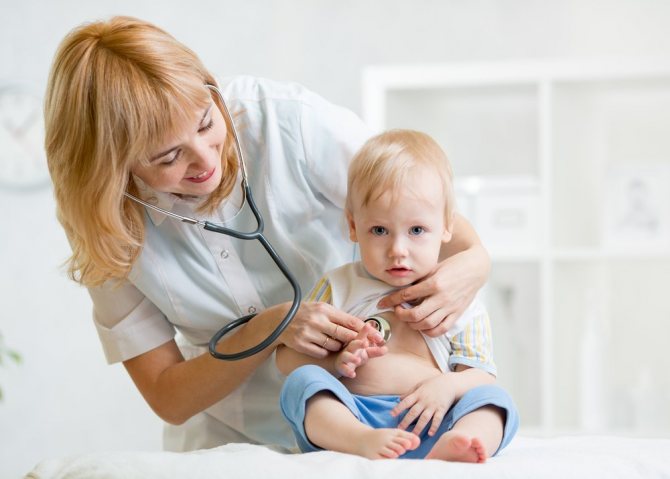Symptoms of food allergies
Symptoms: redness, rash on the body, peeling and itching of the skin
Allergies in infants have different manifestations, the main ones being:
- redness;
- rash on the body;
- peeling and itching of the skin;
- diaper rash;
- gneiss;
- Quincke's edema.
If the gastrointestinal tract is affected by allergens:
- vomit;
- regurgitation;
- diarrhea;
- colic;
- constipation;
- flatulence.
Allergic reactions of a respiratory nature:
- bronchospasm;
- suffocation;
- cough;
- dyspnea;
- allergic runny nose.
These manifestations can occur individually or in combination with each other.
Allergic rashes in newborns
Due to the occurrence of an allergy in an infant, it can be food, contact, or drug. Pathogens include food, breast milk, household chemicals, children's perfumes, medications, vaccines, insect bites and poison.
Manifestation of exudative atopic dermatitis on the face of a baby
Diagnosis of allergies and identification of allergens is carried out only by specialist doctors: a pediatrician, an allergist-immunologist. An examination of the child, a blood test, and additional instrumental examination methods are required.
The presence of an increased level of IgE and eosinophils in a blood test allows you to understand and more accurately recognize an allergic reaction, and find out the main allergen. Questioning parents and keeping a food diary helps determine the connection between exposure to certain factors, food intake and symptoms of hypersensitivity.
- The most common complication is bronchial asthma, a long-term disease of an infectious-allergic nature with frequent exacerbations.
- It is possible to develop chronic damage to the hematopoietic system - hemolytic anemia. The main symptom of this disease is the accelerated destruction of red blood cells.
- However, the most dangerous conditions are considered to be angioedema and anaphylactic shock. These conditions appear suddenly, develop rapidly and are treated only in a hospital setting.
To cure an allergy in an infant, you must first remove the allergen. When breastfeeding, a woman must choose her food carefully. Citrus fruits, honey and bee products, red fruits and vegetables, baked goods, chocolate, canned and smoked foods, milk, nuts, fish and seafood are completely excluded from the diet.
Can you be allergic to breast milk? Alas, even a newborn baby is not immune from this. If we omit hereditary factors, an allergy to breast milk is most often associated with the diet of a nursing mother. Therefore, the basis of treatment in this case is a thorough analysis and adjustment of the mother’s menu.
First of all, potential allergens are excluded: cow's milk (the baby's immune system views cow protein as foreign), chicken eggs, fish and seafood, mushrooms, nuts, honey and brightly colored vegetables and fruits. In the first 2–3 months of life, the baby’s digestive tract is just forming and there are no protective enzymes, so the young mother must be extremely attentive to what she eats.
A doctor's help is also necessary if the baby is on artificial nutrition and the mother suspects that an allergic reaction is caused by components of the infant formula. In this case, after the examination, the allergist will prescribe a hypoallergenic diet for the child.
What are the symptoms of allergies in an infant? The entry of a foreign antigen into the baby’s body can be expressed in different ways:
- various rashes;
- peeling skin on the cheeks;
- diaper rash;
- constant nasal congestion;
- excessive regurgitation;
- vomiting and loose stools;
- difficulty breathing;
- Quincke's edema (in extremely rare cases).
Agree, some of these symptoms are extremely similar to prickly heat and diathesis. How to correctly identify them? Miliaria in the form of small blisters in the folds of the skin and on the neck usually does not cause discomfort to the baby and goes away without a trace after 2-3 days (provided there is no overheating in the future). Diathesis is nothing more than the first bell, forcing the mother to seriously think about the child’s tendency to allergies.
It is directly related to the baby’s adaptation to the external environment and the formation of its gastrointestinal tract. The most common causes of diathesis are dry air, chlorinated water, washing powders and, of course, the mother’s improper diet. Diathesis is manifested by loose stools, a bright rash, red cheeks, but with proper therapy it disappears without a trace in the first years of life.
We invite you to familiarize yourself with the Vitamin complex for hair growth
So, we are very close to the appearance of allergic reactions in infants that are not related to food. In the vast majority of cases, their cause lies in heredity and constant contact with the allergen. Most often, the body's reaction can be caused by:
- dust and dust mites;
- animal hair;
- plant pollen;
- household chemicals;
- children's cosmetics.
To find out what exactly caused the allergic reaction, the doctor performs skin tests. To do this, apply one or another suspected allergen to the baby’s skin and monitor the reaction. If after a certain time the skin has not changed, move on to the next possible “culprit”...
I would like to make a separate point about the baby’s allergic reaction to diapers. In this case, the rash consists of small dots with redness, itching, and swelling, which invariably raises a lot of questions for parents. The first step is to exclude diaper dermatitis, which manifests itself with rare diaper changes, and the factor of mechanical irritation (inconvenient Velcro and elastic bands). In other cases, allergies may occur due to:
- using cheap diapers made from low-quality materials or counterfeits;
- frequent changes of brands of diapers;
- additional components in the composition of diapers (chamomile, aloe).

Get rid of allergies, pick up a healing ointment and switch to Huggies - diapers with natural 100% cotton and hypoallergenic porous materials that allow your baby's skin to breathe.
As mentioned earlier, the main treatment of allergic manifestations is aimed at eliminating the cause. Having noticed allergy symptoms in an infant, the baby should be immediately shown to the attending physician, who will help eliminate all possible allergens, relieve symptoms and prevent progression. If the allergic reaction occurs quickly enough and is life-threatening, the baby should immediately be given antihistamines (suprastin, zodak) and call an ambulance.
The allergic reaction of the child's body is caused by its increased sensitivity to the effects of a wide variety of exo- and endogenous factors. At the same time, the child’s immunity can give a negative response to a variety of substances.
Allergies in newborns who are breastfed are much less common than in children who are given artificial formula. If a baby who is breastfeeding develops an allergy, the mother should under no circumstances stop breastfeeding the baby. On the contrary, maintain lactation as long as possible. After all, only mother’s breast milk has unique properties. Considering that the baby is sprinkled, the mother needs to adhere to a certain diet.
To prevent the development of skin allergies in a child in the future, you need to know the symptoms of the disease. Most babies' skin is affected. You can find out what allergies look like in a newborn from your local pediatrician. As a rule, allergic rashes in a child appear throughout the body, most often they are localized in the neck, face, buttocks and forearms. Due to constant itching, babies are constantly capricious, sleep poorly, often cry and refuse to eat.
In parallel with rashes, infants are diagnosed with dysfunction of the digestive system. If the allergen is in the air, the typical red spots on the body of newborns may not appear.
Experts distinguish several types of allergies in infants:
- Exudative diathesis. Most often diagnosed on the cheeks. Skin redness and severe peeling are observed. Crusts form on the scalp.
- Milk eschar is the formation of small, weeping plaques in the forehead, cheeks, chest and buttocks.
- Seborrhea – formation of crusts and scales is observed on the scalp and eyebrow area.
- Diaper rash. Most often they are localized behind the ears, armpits and in the groin area.
Note. A rash in a baby does not always mean that the child’s body is exposed to an allergen.

Skin rashes in a baby can have different etiologies, so in order to make an accurate diagnosis, you need to be able to distinguish allergies from other pathologies. For example, during the so-called flowering period, the baby may develop small millet spots of a red-pink hue. The etiology of these rashes is associated with hormonal imbalance in the child. Such a rash may not cover a specific area, as in allergic reactions, but almost the entire surface of the body.
Many parents often confuse common prickly heat with allergies. It does not appear as rashes, but as red spots, which are associated with diaper rash.

Allergies in infants should not be left without medical attention
Important! The most common food allergies are nuts, peanuts, red berries, chicken, eggs, seafood and cheese.
The list of substances that can cause allergic reactions in both children and adults is quite long. There are a huge number of potentially dangerous compounds around us. Many of them appeared thanks to the development of civilization. However, this does not mean that allergens are exclusively products of the chemical industry and man-made compounds. Many allergens are present in natural materials and biological objects.
Allergy to mosquito bites is medically called culicidosis. This disease can be recognized by the following symptoms:
- severe itching;
- swelling and hyperemia near the bite site;
- blistering;
- a sharp deterioration in general health;
- nausea;
- vomit;
- tachycardia;
- decreased blood pressure;
- sometimes there are attacks of suffocation;
- anaphylactic shock and Quincke's edema occur in extremely difficult cases.
Note. Severe manifestations are more likely when there are a large number of insect bites, as well as in people prone to allergies. In this case, only a specialist can quickly cure a person.
Other forms
Diathesis in a child.
Causes of allergies in infants
The main source of food allergies are protein compounds
The main source of food allergies are protein compounds. The manifestation of allergy symptoms is a protective reaction of the body. Only through symptoms can the disease be identified. If a person did not feel pain and the disease proceeded in a latent phase, treatment would be complicated. When treating allergies, it is necessary to treat not the external symptoms, but the “hidden enemy” located inside the body.
The risk of allergies in infants is influenced by the health and hereditary diseases of their parents. Mom's health is of paramount importance.
The development of a child's body is influenced by the conditions of its gestation in the womb. During this period, even a minor respiratory disease can negatively affect the child’s health.
In the first year of life, the microflora of the baby’s gastrointestinal tract contains substances that promote the proper breakdown of essential microelements. Even an adult receives anti-allergen vaccinations to strengthen resistance to allergens. At the initial stage, the baby’s weak body copes with them on its own and at times is not effective.
The high probability of allergens is associated with increased permeability of the walls of the gastrointestinal tract, as a result of which they penetrate into the blood, which distributes them throughout the body.
How to determine what a baby is allergic to?
If you experience the first signs of an allergy, even if you have doubts, you should consult a doctor.
If you experience the first signs of an allergy, even if you have doubts, you should consult a doctor. In case of aggressive and life-threatening manifestations, hospitalization in a hospital is possible. Diagnostic methods:
- identifying the relationship between food and allergies;
- parent survey;
- visual inspection;
- ultrasound examination of internal organs.
- a high concentration of eosinophils and immunoglobulin E in the blood indicates the presence of an allergy.
Once the fact of an allergy has been established, doctors begin to identify the source of the allergen. Otherwise, the treatment will be ineffective. At this stage, reference allergens contained in food products are applied to the child’s skin and it is determined which of them causes an allergic reaction.
Parents are advised to keep a food diary when feeding their child. Thanks to him, the doctor will be able to identify the allergen in the child’s body and develop a treatment method. The diary should systematically reflect the child’s health status.
Treatment of allergies in newborns
The first step, if signs of an allergy appear in an infant, is to inform the pediatrician and obtain from him the necessary recommendations for further treatment. If the child has all the symptoms of an allergy, specialists will draw blood from a vein, which will determine the presence of immunoglobulins E in it. A diary in which the mother should record the foods consumed by her, in the case of breastfeeding, and the child, can help identify the allergen in the child. Its effectiveness in such cases is very difficult to overestimate. Treatment of allergies first begins with diet and the exclusion of all kinds of allergenic foods from the diet of the mother and baby. Treatment tactics using diet are chosen exclusively by an allergist.
However, before the pediatrician arrives, you should know how to provide the necessary care for your child. For example, in the case of bronchospasm, it is necessary to give a child of the first year of life an antihistamine that contains suprastin or claritin.
Allergy treatment
If you have an allergy, you need to choose the right diet, especially if it is caused by any product.
If you have an allergy, you need to choose the right diet, especially if it is caused by any product. What to do if symptoms such as bronchospasm and allergic edema appear against the background of allergies? Seek professional medical help.
The following medications are used:
- Suprastin;
- Diprazine;
- Diazolin;
- Claritin.
Dietary recommendations for breastfeeding mothers
The diet must be followed not only until the allergy is completely cured, but also subsequently until the body is completely stronger
Products that contain a large number of allergens:
- seafood;
- chicken eggs;
- mushrooms;
- honey;
- nuts;
- chocolate;
- cocoa;
- coffee;
- red berries and fruits;
- citrus;
- grape;
- marinades;
- broths;
- spicy and salty dishes;
- canned food;
- spices;
- garlic;
- onion.
Restricted products:
- milk products;
- flour products;
- semolina.
Products with the lowest allergen content:
- cottage cheese;
- kefir;
- yogurt;
- hard cheese;
- buckwheat;
- corn;
- rice;
- oatmeal;
- lean meat;
- vegetable oil;
- tea;
- compote.
If the allergy manifests itself during artificial feeding, then there is a high probability that the allergen may be in the protein of cow's milk. In this case, such products are replaced with mixtures with proteins of plant origin.
The diet must be followed not only until the allergy is completely cured, but also subsequently until the body is completely stronger. Over time, expand your diet, excluding highly allergenic foods.
Causes of allergies in newborns
Completely all products that contain allergens and which the mother eats also enter the child’s body, not to mention the fact that the baby can directly consume these products. Hereditary factors, fetal hypoxia, difficult childbirth, and previous acute intestinal or respiratory viral infections also play an important role. We must not forget about the low functional characteristics of the newborn’s digestive tract. The antibodies of his body are not yet ready to fully cope with all external factors and provide the necessary protection to the intestinal mucosa.
Smoking during pregnancy also increases the likelihood of allergies in a child. Allergies in a baby can also appear as a result of the expectant mother’s passion for allergenic high-calorie foods. During the newborn period, the baby may react acutely to the following foods: cow's milk, fish caviar, seafood, orange, red vegetables and fruits, chicken eggs, cocoa, mushrooms, honey, coffee, chocolate, nuts.
What else can cause allergic reactions in a baby? A food allergy is a reaction to proteins found in many foods. It should be noted that some food allergens have the ability to change their allergic properties downward after cooking, while others may, on the contrary, increase it even more.
It is very important to be careful when switching to formula from breastfeeding, as the newborn may become intolerant to milk protein.
In addition to food, allergies in infants can be caused by vaccinations, infectious diseases or antibiotics.
What to do if your baby is susceptible to allergies?
Not all children are born with a strong body; if the immune system is weak, it needs to be strengthened, preventing the manifestation of diseases
Not all children are born with a strong body; if the immune system is weak, it needs to be strengthened, preventing the manifestation of diseases.
In this case, you need to follow the recommendations:
- do not use pharmacological syrups with flavors and dyes;
- ensure proper emptying of the gastrointestinal tract;
- bathing a child should last no more than half an hour;
- do not allow swimming in unboiled water;
- use hypoallergenic children's cosmetics;
- limit the presence of animals indoors;
- When bathing, do not rub the baby’s skin too hard with a washcloth;
- children's clothing and bedding should be made of cotton and wool, without synthetics and dyes;
- Ventilate the room regularly.
An allergy in a baby is not a death sentence. If parents regularly monitor the child’s health and take measures to strengthen it, then over time he will become stronger and be able to withstand many adversities. According to statistics, 99% of children are completely cured over time from allergies that appeared at an early age.











